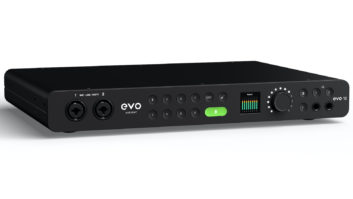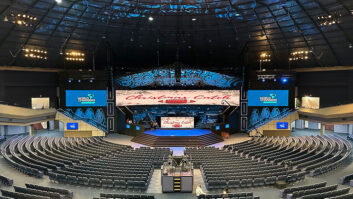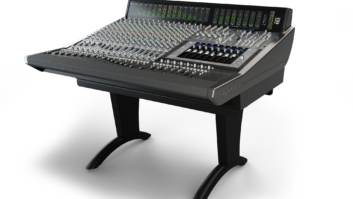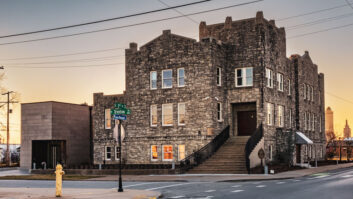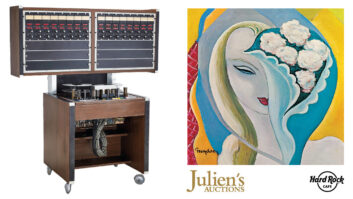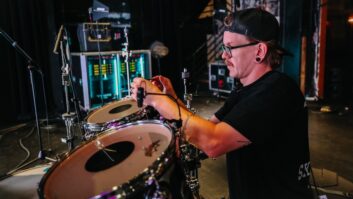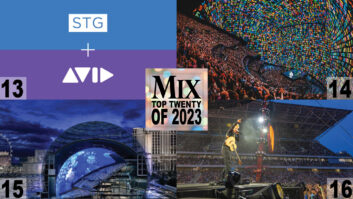ANAHEIM, CALIFORNIA – SEPTEMBER 2012: The modest sanctuary of St. Anthony Claret Catholic Church in Anaheim, California is of an airy and lovely modernist design. It was at the height of architectural fashion when it was built in the late 1950s and has again come into vogue in the new century. However, its unintelligible sound reinforcement system was hardly state-of-the-art when installed decades ago, and unlike a fine wine, time did not make it sound any better. As the church’s musical ambitions and spoken word requirements grew through the years, Reverend Rudolph Preciado contacted Newport Beach-based 7K Solutions to remedy the antiquated audio. Paul Dexter, owner of 7K Solutions, used an open-architecture Symetrix SymNet Solus 16 processor to create a system with twelve open inputs that could automix itself.
“Reverend Preciado will be retiring soon, and he wanted to do something great for the church before he left,” said Dexter. “The old sound reinforcement system was not performing well. An early-1980s rack of analog processing and amplification that had become ever-more ‘Frankensteined’ through the years drove a ceiling full of eight-inch, full-range loudspeakers.”
When it was constructed, the church used a charming pipe organ as the sole musical source and had only modest spoken word requirements. Today, the pipe organ is joined by a choir and, for some services, by a band that mixes itself on stage. Three microphones cover the choir, and Dexter replaced the band’s old mixer with an Allen & Heath MixWizard. Instead of a boundary mic at the altar, St. Anthony Claret now uses three wireless headset microphones for the priests, one wireless handheld microphone, and four optional podium microphones.
The Symetrix SymNet Solus 16 is an open-architecture, stand-alone unit that provides sixteen mic/line inputs and eight outputs. The routing, logic, and signal processing that Dexter programmed was quite involved and reflected the specific uses and contexts of each input. For instance, the band’s input will not duck for any other input. In contrast, all of the microphones will duck in response to the headset microphones. Dexter used Symetrix’ time-tested auto-gain algorithm on all of the microphones to ensure that individuals with both quiet and loud speaking voices receive ideal reinforcement.
“I started using Symetrix processing several years ago,” said Dexter. “I’m not the sort of person who’s into taking classes and certifications, so I appreciate how really intuitive SymNet Designer is. But things always come up, and I can call the Symetrix support staff any time and speak with someone who is knowledgeable and interested. My question gets answered and I move on. The SymNet Solus 16 was the perfect solution at St. Anthony Claret because I knew sixteen inputs would be ample and eight outputs was all that were needed. The open-architecture programming would allow me to customize the system for the very particular needs of this church.”
In addition to some clever processing inside the SymNet Solus 16, Dexter corrected the intelligibility problem with a generous helping of acoustical treatment and a single, nearly-point source loudspeaker cluster. “The walls, ceiling, floor, and pews are all quite reflective,” he said. “It was originally meant to amplify the pipe organ.” Dexter placed absorptive panels on the ceiling, sidewalls, and back wall, taking care to match colors so that the aesthetic of the church wouldn’t be compromised. He placed several panels on the ceiling near the central loudspeaker cluster so as to minimize intelligibility-degrading early reflections. The loudspeakers are Fulcrum Acoustic DX1265s, powered by Powersoft amplifiers.
Just a single Symetrix ARC-2e wall panel remote provides all of the user control for the system. Dexter fixed the sanctuary’s output volume and then provided ten steps of volume control for wireless microphones (as a group), the podium microphones (as a group), the choir microphones (as a group), and the band’s on-stage mixer. Additional menu pages provide output volume for the choir monitor (which contains all content except the choir mics) and the cry room. Behind the scenes, the SymNet Solus 16 provides additional zone control for the foyer and each main loudspeaker. Zoning out the loudspeaker cluster allowed Dexter to shade and tune each element to deliver even coverage from the front seat to the back wall.
“Taken together, the system is very effective,” said Dexter. “It sounds great, and they don’t need an audio tech on hand. Reverend Preciado tested the system with us, and he walked all around the room, overjoyed by how clear everything sounded. And it’s so easy to use that we never had to provide a formal training session. The Reverend just pushed some buttons on the ARC-2e, and he understood exactly how it works.”
ABOUT SYMETRIX
Sound professionals rely upon the performance, value and reliability of audio mixing, routing and processing products from Symetrix. For more information on Symetrix professional audio products, please visit www.symetrix.co or call +1 (425) 778-7728.

